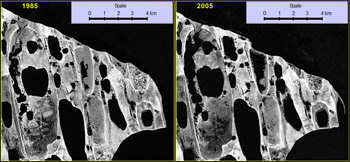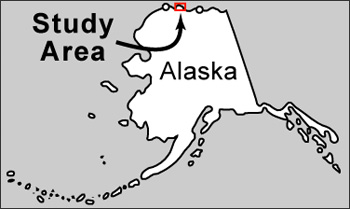
“This area’s increased rate of coastal erosion over these time increments may be the result of greater wave action caused by earlier seasonal melting and reduced size of the Arctic ice pack, which warrants further study,” said USGS scientist John Mars. “Since beaches are absent or poorly developed along most of the studied coast, there is little, if any, protection against this increased wave energy. As a result, the waves undercut the mud-rich permafrost land, causing it to collapse into the sea. As the permafrost blocks melt, the muddy sediment they contain is re-suspended in the water and carried offshore.”
 USGS images of Alaska’s coast during each time increment, consolidated to show the net-change in land loss and land gain, as well as coastal lake drainage and flooding, can be found at the Alaska Coastal Erosion Web site.The report, titled “Quantitative Remote Sensing Study Indicates Doubling of Coastal Erosion Rate in Past 50 Years along a Segment of the Arctic Coast of Alaska,” by USGS scientists John Mars and David Houseknecht, can be found on the Geological Society of America Web site.
USGS images of Alaska’s coast during each time increment, consolidated to show the net-change in land loss and land gain, as well as coastal lake drainage and flooding, can be found at the Alaska Coastal Erosion Web site.The report, titled “Quantitative Remote Sensing Study Indicates Doubling of Coastal Erosion Rate in Past 50 Years along a Segment of the Arctic Coast of Alaska,” by USGS scientists John Mars and David Houseknecht, can be found on the Geological Society of America Web site.
Scientists believe these results can help land and resource managers make informed decisions about managing the Arctic area’s oil and gas exploration and wildlife habitats, as well as contribute to a greater understanding of geologic processes and anticipate future change.
+ See USGS press release
Contributor: John Mars & Jessica Robertson, USGS

Be Part of What’s Next: Emerging Applications of Landsat at AGU24
Anyone making innovative use of Landsat data to meet societal needs today and during coming decades is encouraged to submit and abstract for the upcoming “Emerging Science Applications of Landsat” session at AGU24.





